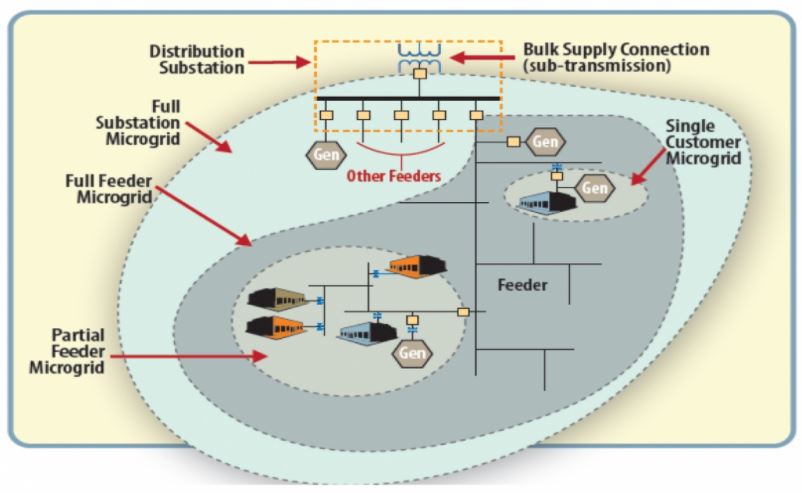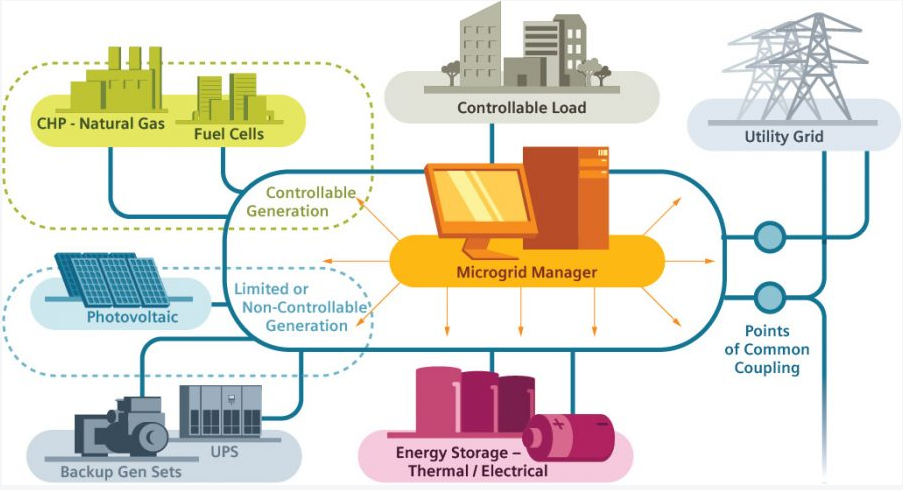A microgrid is a group of interconnected loads and distributed energy resources within clearly defined electrical boundaries that acts as a single controllable entity with respect to the grid. This means a microgrid can connect and disconnect from the grid to enable it to operate in both grid-connected or island-mode.[1] The development of microgrids as an emerging resource provides practical answers to the energy challenges of the 21st century by creating an optimized way to access reliable, clean, and resilient energy through local, interconnected energy systems that incorporate loads, decentralized energy resources, battery storage, and control capabilities.

Distributed Energy Resources
Distributed energy resources (DER), also called on-site generation, dispersed or decentralized generation, are small power sources that can be combined to provide power to satisfy demand.[2] Such sources can include micro-turbines, small natural gas-fueled generators, combined heat and power plants, battery storage, biomass, wind and solar thermal or photovoltaic installations. Use of DERs is becoming more common due to potential for more affordable renewable energy, and an increased desire for grid resiliency, especially during disasters. The intermittent nature of DERs remains a challenge for utilities, and complex and expensive integration upgrades and power-balancing mechanisms will be required as use of DER increases.[3]
Smart Grid
Technologies that not only allow for two-way communication between a utility and its customers but sensing capabilities along transmission lines that respond to needed load in real time describes smart grid technologies. Emerging smart grid technologies could make it possible for consumers to individually balance their energy supply and demand. Allowing consumers to adjust electricity use in response to available supplies and costs could enhance the capacity and flexibility of the power system and may have a significant impact on Idaho energy networks. Smart grid development may facilitate the deployment of electric vehicles and help reduce carbon emissions in the transportation sector. The development of new energy storage technologies will impact both the feasibility of fuel-switching in the transportation sector (gas to electric) as well as grid stability through grid-scale energy storage.[4]
To understand how a microgrid works, you first have to understand how the centralized electric grid works. The grid connects homes, businesses and other buildings to central power sources, which allow us to use appliances, heating/cooling systems and electronics. But this interconnectedness means that when part of the grid needs to be repaired, everyone is affected.
Microgrids are miniature versions of the centralized electric grid that dispatches, distributes, and regulates the flow of electricity. They can operate and switch between either grid connected or islanded modes, where the microgrid can disconnect from the grid to operate autonomously. Because they are able to operate while the main grid is down, microgrids can strengthen grid resilience and help mitigate grid disturbances as well as function as a grid resource for faster system response and recovery.
A microgrid not only provides backup for the grid in case of emergencies, but can also be used to cut costs, or connect to a local resource that is too small or unreliable for traditional grid use. A microgrid allows communities to be more energy independent and, in some cases, more environmentally friendly.
A microgrid can be powered by distributed generators, batteries, and/or renewable resources like solar panels, and can come in a variety of designs and sizes.

Microgrids work best in locations with complex energy needs. Below are the major entities that can benefit most from a microgrid, and the problems they would help to solve:
- Utility Providers
- Enable high-penetration renewables
- Avoided or deferred distribution investments for T&D upgrades
- Avoided transmission energy losses
- Restoration and black start benefits
- Cities & Municipalities
- Increase energy reliability and resiliency against events that cause grid outages
- Integrate cost effective solutions
- Use government incentives and programs for investment in our electrical future
- Government
- Increase energy security for critical facilities
- Reduce dependence on aging infrastructure
- Reduce energy costs
- Reduce emissions
- Commercial & Industrial
- Reduce energy costs
- Utilize increased energy market participation options
- Adopt renewable and on-site energy for sustainability
- Use government incentives and programs for investment in our electrical future
- Improve cost and reliability through localized energy and the associated advanced control
The U.S. Department of Energy (DOE), Office of Electricity has a comprehensive portfolio of activities that focuses on the development and implementation of microgrids to further improve reliability and resiliency of the grid, help communities better prepare for future weather events, and keep the nation moving toward a cleaner energy future.
Key R&D activities undertaken by the DOE’s National Laboratories are in two focus areas:
- Planning and design, addressing system architecture, monitoring and analysis, and system design; and
- Operations and control, addressing steady-state control and coordination, transient-state control and protection, and operational optimization.
Resources
- The Distributed Energy Resources Customer Adoption Model (DER-CAM) is an economic and environmental model that has been in development at Lawrence Berkeley National Laboratory since 2000. The model’s objective is to minimize the cost of operating on-site generation and combined heat and power systems.
- The Microgrid Design Toolkit (MDT), which was developed by Sandia National Laboratories, is a decision support software tool for microgrid designers that is intended to be used in the early stages of the design process. The tool uses powerful search algorithms to identify and characterize alternative microgrid design decisions in terms of user-defined objectives such as cost, performance, and reliability.
- The Smart Power Infrastructure Demonstration and Energy Reliability and Security (SPIDERS) project is a Joint Capability Technology Demonstration between the U.S. Department of Energy, U.S. Department of Defense and U.S. Department of Homeland Security that is focused on demonstrating a secure microgrid architecture with the ability to maintain operational surety through trusted, reliable, and resilient electric power generation and distribution on military installations.
Studies
- Los Amos National Laboratory, DC Microgrids Scoping Study – Estimate of Technical and Economic Benefits
- National Renewable Energy Laboratory, Phase I Microgrid Cost Study: Data Collection and Analysis of Microgrid Costs in the United States
- Sandia National Laboratories, The Advanced Microgrid – Integration and Interoperability
- Smart Electric Power Alliance, The Microgrid Playbook: Community Resilience for Natural Disasters
 Official Government Website
Official Government Website